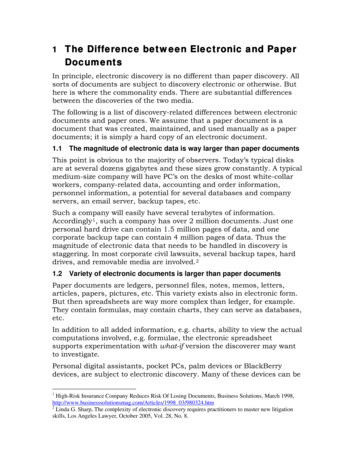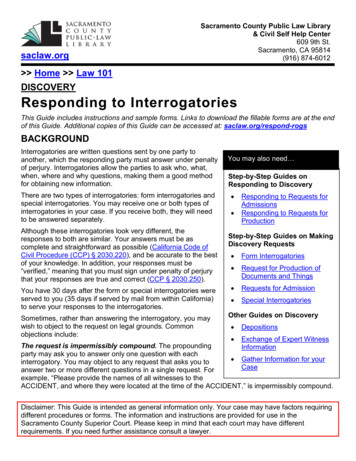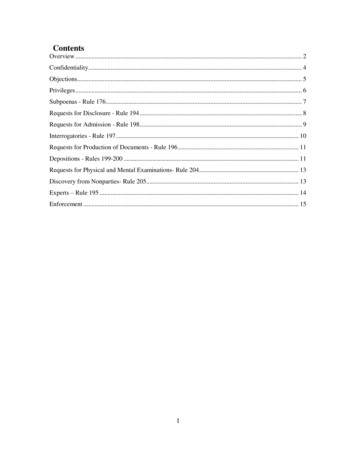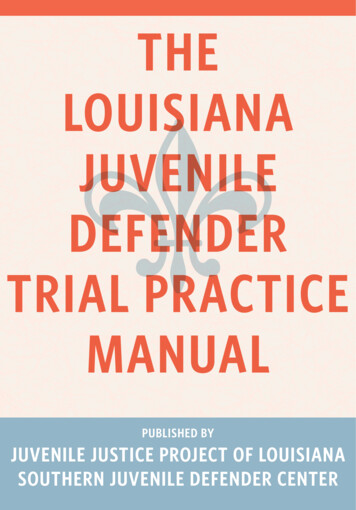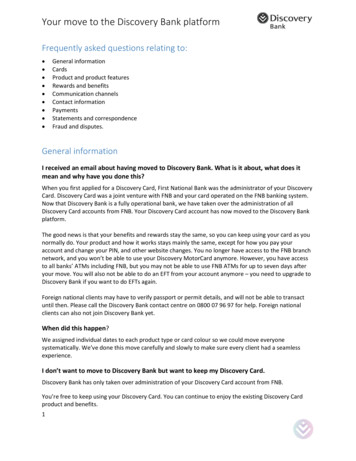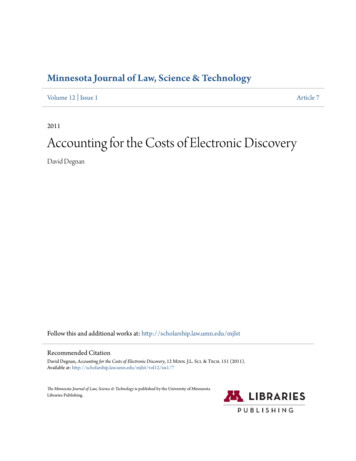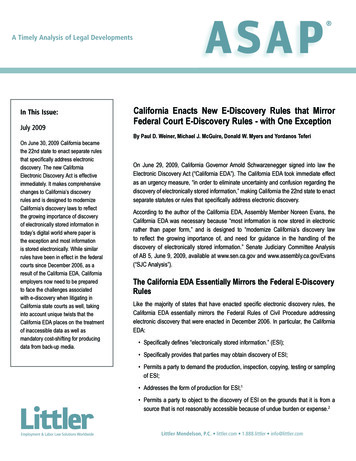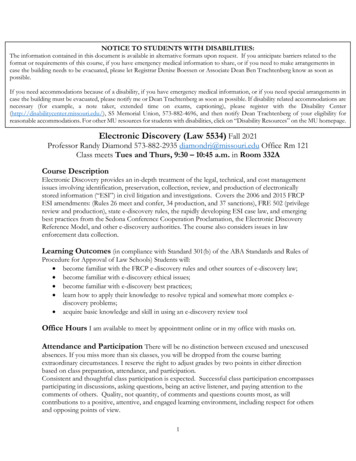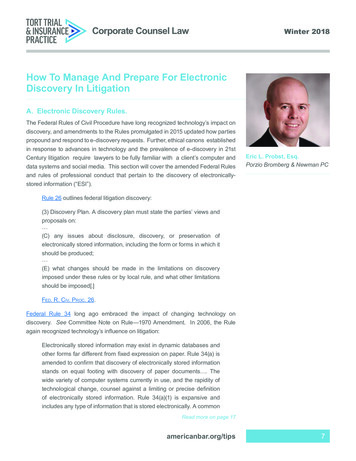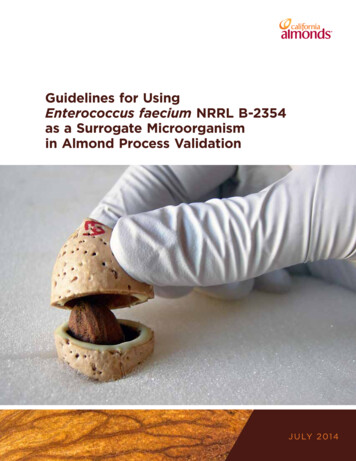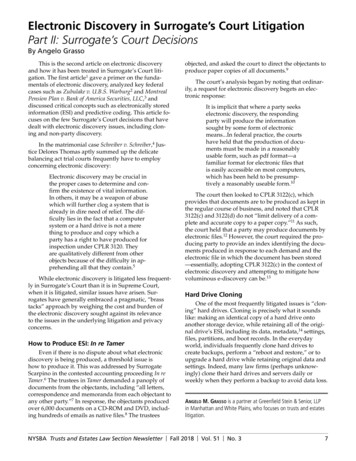
Transcription
Electronic Discovery in Surrogate’s Court LitigationPart II: Surrogate’s Court DecisionsBy Angelo GrassoThis is the second article on electronic discoveryand how it has been treated in Surrogate’s Court litigation. The first article1 gave a primer on the fundamentals of electronic discovery, analyzed key federalcases such as Zubulake v. U.B.S. Warburg2 and MontrealPension Plan v. Bank of America Securities, LLC,3 anddiscussed critical concepts such as electronically storedinformation (ESI) and predictive coding. This article focuses on the few Surrogate’s Court decisions that havedealt with electronic discovery issues, including cloning and non-party discovery.In the matrimonial case Schreiber v. Schreiber,4 Justice Delores Thomas aptly summed up the delicatebalancing act trial courts frequently have to employconcerning electronic discovery:Electronic discovery may be crucial inthe proper cases to determine and confirm the existence of vital information.In others, it may be a weapon of abusewhich will further clog a system that isalready in dire need of relief. The difficulty lies in the fact that a computersystem or a hard drive is not a merething to produce and copy which aparty has a right to have produced forinspection under CPLR 3120. Theyare qualitatively different from otherobjects because of the difficulty in apprehending all that they contain.5While electronic discovery is litigated less frequently in Surrogate’s Court than it is in Supreme Court,when it is litigated, similar issues have arisen. Surrogates have generally embraced a pragmatic, “brasstacks” approach by weighing the cost and burden ofthe electronic discovery sought against its relevanceto the issues in the underlying litigation and privacyconcerns.How to Produce ESI: In re TamerEven if there is no dispute about what electronicdiscovery is being produced, a threshold issue ishow to produce it. This was addressed by SurrogateScarpino in the contested accounting proceeding In reTamer.6 The trustees in Tamer demanded a panoply ofdocuments from the objectants, including “all letters,correspondence and memoranda from each objectant toany other party.”7 In response, the objectants producedover 6,000 documents on a CD-ROM and DVD, including hundreds of emails as native files.8 The trusteesobjected, and asked the court to direct the objectants toproduce paper copies of all documents.9The court’s analysis began by noting that ordinarily, a request for electronic discovery begets an electronic response:It is implicit that where a party seekselectronic discovery, the respondingparty will produce the informationsought by some form of electronicmeans.In federal practice, the courtshave held that the production of documents must be made in a reasonablyusable form, such as pdf format—afamiliar format for electronic files thatis easily accessible on most computers,which has been held to be presumptively a reasonably useable form.10The court then looked to CPLR 3122(c), whichprovides that documents are to be produced as kept inthe regular course of business, and noted that CPLR3122(c) and 3122(d) do not “limit delivery of a complete and accurate copy to a paper copy.”11 As such,the court held that a party may produce documents byelectronic files.12 However, the court required the producing party to provide an index identifying the documents produced in response to each demand and theelectronic file in which the document has been stored—essentially, adopting CPLR 3122(c) in the context ofelectronic discovery and attempting to mitigate howvoluminous e-discovery can be.13Hard Drive CloningOne of the most frequently litigated issues is “cloning” hard drives. Cloning is precisely what it soundslike: making an identical copy of a hard drive ontoanother storage device, while retaining all of the original drive’s ESI, including its data, metadata,14 settings,files, partitions, and boot records. In the everydayworld, individuals frequently clone hard drives tocreate backups, perform a “reboot and restore,” or toupgrade a hard drive while retaining original data andsettings. Indeed, many law firms (perhaps unknowingly) clone their hard drives and servers daily orweekly when they perform a backup to avoid data loss.Angelo M. Grasso is a partner at Greenfield Stein & Senior, LLPin Manhattan and White Plains, who focuses on trusts and estateslitigation.NYSBA Trusts and Estates Law Section Newsletter Fall 2018 Vol. 51 No. 37
In litigation, drives are cloned to permit the litigants touse the cloned drive for discovery while the owner ofthe original drive can continue to use the machine orserver.The drawbacks of cloning are readily apparent.While cloning is relatively inexpensive and easy toperform, it will interrupt the owner’s ability to useher computer or server. More problematically, cloningis a blunt instrument that ensures that all data on aparticular hard drive is preserved. It does not performa content-based analysis, meaning there is significantrisk that privileged or confidential information will beinadvertently disclosed. This is particularly true if anattorney’s hard drive or server is being cloned, unlesshe or she has a special practice and handles only oneclient.15 Without taking the proper precautions, cloningan attorney’s hard drive will result in a stranger receiving gigabytes of clients’ ESI without their permission,creating ethical issues for the attorney.One of the earliest state court cases to addresscloning was the matrimonial action Etzion v. Etzion,16where the plaintiff brought an order to show cause to“impound, clone and inspect” various computer servers, drives, work stations and computers belongingto her husband.17 The basis for her electronic fishingexpedition was her claim that her spouse had engagedin years of fraudulent conduct, such as diverting millions of dollars from assets in which she had an interest.18 Thus, she took a “preemptive strike” to preventdestruction of the records on the machines that wouldlikely contain the damning information.19 In a decision balancing the importance of full discovery withthe need for privacy and confidentiality, the court required the defendant to present the hard drives to theplaintiff’s expert for cloning. The cloned drives wouldthen be turned over to a referee, who would examinethe contents of the drives, and create hard copies of therelevant records in accordance with detailed guidelinesset forth in the decision.20While the court’s solution in Etzion balanced thecompeting interests, it had an obvious drawback: itwas expensive. The court declined to shift any of thecost of the electronic discovery to the defendant, holding that under the CPLR, the party seeking discoverygenerally incurs the costs of producing the material.21Here, that was at least 30,000 for the expert and attorney’s fees, plus a portion of the referee’s fee. Becausea large amount of money at stake in Etzion, the costpotentially justified the expense. In most Surrogate’sCourt cases, a 30,000 cost for some discovery wouldbe a significant impediment.Non-Party Discovery: In re MauraWhile Etzion concerned electronic discovery froma party, In re Maura22 was one of the first Surrogate’sCourt cases to consider electronic discovery of a non8party. In Maura, decedent and his spouse executed aprenuptial agreement drafted by the same attorney, inwhich both renounced their spousal right of election.23The decedent’s will did not provide for his spouse.24After the surviving spouse filed and served her noticeof election, the estate fiduciaries commenced a proceeding to deny the widow her elective share.25 Thewidow responded that the prenuptial agreement wasthe product of fraud, undue influence and deception,that she was not represented by counsel (even thoughshe shared an attorney with her husband), and that theprenuptial agreement was altered or amended.26After the attorney-drafter’s three-day deposition,the widow served a subpoena duces tecum on both theattorney and the firm at which the attorney was “ofcounsel,”27 demanding four types of ESI to ascertainwhether any deletions, insertions or alterations weremade to the prenuptial agreement: All existing and deleted records of the prenuptial agreement; Recreations of the attorney’s and firm’sbilling records for estate planning and theprenuptial agreement; All other records concerning estate planning for the Decedent; and Sample copies of other prenuptial agreements prepared by the attorney.28After both the attorney and the firm objected tothe subpoena, the widow moved to compel.29 As partof her motion to compel, the widow submitted a proposal from a computer expert as to how the electronicdiscovery would be conducted. The expert recommended taking the attorneys’ hard drive, cloning it atthe expert’s office, downloading the necessary documents, placing them in a sealed envelope to be delivered to the court, and allowing the non-party attorneyand firm to make any privilege objections within tendays.30 While the widow was willing to bear the costof the electronic discovery, she argued that if the nonparty attorneys wanted their own expert to oversee theproject, then that cost should be borne by them.31Unsurprisingly, the non-parties opposed the motion, arguing the discovery sought was invasive, ascloning the hard drive would give the widow unfettered access to information and data well beyond thescope of the subpoena, including “the firm’s personaland personnel information” and currently pendingcases.32 As a compromise, the non-parties proposedacquiring the requested information from the firm’sbackup tape.33 Problematically, the non-parties conceded that the information on the tape would not bein retrievable form—meaning a forensic expert wouldbe required, increasing the cost—and that this methodwould not provide information on changes or dele-NYSBA Trusts and Estates Law Section Newsletter Fall 2018 Vol. 51 No. 3
tions to the prenuptial agreement.34 The non-party attorneys further demanded that in any event, the widowshould bear all costs.35The court denied all discovery concerning thefirm’s billing records relating to estate planning and theelectronic version of the estate planning file, holdingthe information sought had no bearing on the validityof the prenuptial agreement, as the widow had the hardcopy of the estate file and there was no allegation thatshe needed to determine whether those files had beenaltered or deleted.36 It also rejected the widow’s requestfor other clients’ prenuptial agreements as privileged,unduly burdensome, and irrelevant to the widow’sclaim the subject prenuptial agreement was altered.37By contrast, the court found that the widow’s requestfor access to the attorney’s computer to copy all billingrecords relating to the prenuptial agreement and theexisting and deleted records concerning the prenuptialagreement were “material and necessary,” as they boreon the agreement’s authenticity.38The court then turned to the question of how toconduct that discovery and who should bear the cost,noting that New York courts frequently look to federalcourts for guidance on electronic discovery, and thatthe federal rules in effect at the time provide protectionfor non-parties against onerous e-discovery.39 Whilenoting that cloning or system access should be allowedsparingly because it raises “inevitable conflicts,” thecourt permitted cloning instead of using the tape backup, as the latter, while less burdensome, “will not yieldthe deleted or altered information” that was the “gravamen” of the authenticity claim.40 The court then setforth a detailed procedure for cloning, which includedan expert of the law firm’s selection, submitting a written proposal, the widow approving it in writing, howobjections to specific records would be interposed, andthe dissemination of the mined data.41 The court allocated all of the cost to the party seeking discovery.42Cloning Part Two: In re Tilimbo and In reCatalanoThe limits of cloning were explored in In re Tilimbo43 and In re Catalano.44 Tilimbo concerned an actionto set aside a deed under Article 15 of the Real PropertyActions and Proceedings Law, which was transferredto the Surrogate’s Court of Bronx County, where itproceeded concurrently with a will contest.45 A keywitness was the non-party attorney who drafted boththe propounded will and purported deed. After theattorney-drafter’s deposition, he was directed to searchhis computer (and other files) for other responsivedocuments and produce them, or provide an affirmation stating a diligent search had been conducted forresponsive documents and none were found.46 Afterdoing so, the attorney provided an affirmation statingall he found were older estate planning documents, ashe had lost most of his file.47Given the paucity of the production, the petitionermoved for permission to clone the attorney’s harddrive (at petitioner’s own cost) for the limited purposeof enabling petitioner’s computer forensic expert tosearch for documents related to Decedent, her will,and the disputed deed transfer.48 The non-party attorney opposed, noting that he had already compliedwith the subpoena as he was deposed and conducted adiligent search of his computer.49 The non-party attorney attempted to distinguish In re Maura by claimingpetitioner’s request was not limited to relevant documents.50For precedence, the court looked to the First Department’s decision in Tener v. Cremer,51 which concerned a subpoena a plaintiff served upon non-partyNYU Hospital seeking “the identity of all persons whoaccessed the Internet” on a specific date from a specificInternet Protocol (IP) address.52 NYU objected, claiming it did not have the capability to retrieve the information sought.53 On reply, the plaintiff submitted anaffidavit from a computer expert setting forth a methodby which the requested data could be retrieved.54The Tener Court sided with the plaintiff, noting thatthe discovery of ESI has become “commonplace,” andthat courts have promulgated guidelines and rules tofacilitate e-discovery, such as 22 N.Y.C.R.R. §202.12(c),Rule 45 of the Federal Rules of Civil Procedure, andthe Commercial Division Rules of the Supreme Courtof Nassau County (“Nassau Guidelines”).55 Upon reviewing all three methodologies, the First Departmentfound that the Nassau Guidelines “provide a practicalapproach” as they require “a cost/benefit analysis involving how difficult and costly it would be to retrieveit.”56 The court further noted that when a non-party isinvolved, the CPLR required the requesting party todefray the non-party’s reasonable production expenses,including the cost of disruption to the business operations of the non-party.57Based on Tener, the Tilimbo Court began by noting that ESI such as raw computer data and electronicdocuments are discoverable under CPLR 3101(a), andthat ESI is “discoverable even when a hard copy isprovided.”58 The court then rejected the non-party’sargument that he already produced hard copies ofdocuments, as that does not preclude producing theESI for the same documents.59 Although the petitionerdid not set forth the details of how the cloning wouldoccur, the court found that based on the record, it appeared the process would only require access to the attorney’s computer for a limited period of time, whichshould not cause an “unreasonable burden” upon theattorney.60 Regardless, cognizant of the fact that theattorney was a solo practitioner, the court set forth adetailed method to ensure the non-party’s disruptionNYSBA Trusts and Estates Law Section Newsletter Fall 2018 Vol. 51 No. 39
was minimal, including requiring that a weekdaycloning take less than four hours at a date and timeof the attorney’s choosing, or over a weekend, andplacing strict guidelines on how the cloning shouldoccur if the scope exceeds one computer and neededto be outside of the attorney’s office.61 As to privilegeissues, the court directed that the forensic examiners may only examine the hard drives for documentsrelated to the decedent, that all recovered documentswere to be sent to the attorney’s counsel, who wouldreview for privilege, and in the event any documentsare deemed privileged, would be sent to the Court foran in camera review.62In re Catalano took a more restrictive view, holdingthat cloning was to be sparingly allowed only undercertain circumstances. Catalano was a SCPA 2103 proceeding in the Surrogate’s Court of Nassau County,where the issues were the assets and operations of several entities that owned and operated a supermarketin which the decedent’s estate had an interest.63 Upona prior order, the respondents were directed to turnover to petitioner the computer taken from Decedent’shome. When the respondents turned over the wrongcomputer and averred that they could not differentiatewhich was the correct computer, petitioner sought toclone all of decedent’s computers.64 In response, therespondent had the technical director for the companyclone and produce the hard drives for all the cashregisters at the stores, which were turned over to thepetitioner.65Since the petitioner had yet to review these documents, his motion to compel was denied with leaveto renew. More critically, the court adopted the FirstDepartment’s holding in Melcher v. Apollo Med. FundMgt. LLC,66 and held that “in the absence of proof thata party intentionally destroyed or withheld evidence,the court should not direct the cloning of that party’shard drives.”67 That said, the court directed that the respondents “ refrain from removing or altering any datacontained within the hard drives of the computers.pending further order of this court,”68 tacitly acknowledging that the possibility existed that this evidencewould be produced at a later date.“I Have a Guy”: In re NunzA final case where cloning and electronic discovery were an issue was In re Nunz, a will contest in ErieCounty.69 In Nunz, the Decedent was survived by hiswife and six children from a prior marriage.70 Thepropounded will left the entire residuary estate to thesurviving spouse.71 After SCPA 1404 examinations, objections to probate were filed by five of the children.72As part of post-objection discovery, a subpoenaduces tecum was served upon the attorney-drafter seeking production of his documents and notes concerningthe preparation of the purported will.73 After produc10ing his handwritten notes, the attorney-drafter signedan affidavit stating that he had prepared the will usingMicrosoft Word, that he had deleted the digital fileimmediately after printing a copy of the will, and thatany computer files related to preparation of the willthat “were created and/or stored in electronic or digital format have been destroyed and no longer exist.”74The objectants responded by serving another subpoenaupon the attorney, now seeking the computer the attorney used in preparing the will.75 With the subpoenacame objectants’ attorney’s cover letter:All I am looking for in this subpoenais the Apple IMAC computer you toldme about in connection with preparingBill Nunz’ will. While you informedme that you deleted the file, I have aguy who thinks he can restore the harddrive and retrieve almost all of it.I imagine that you have concerns overconfidentiality for your other clients astheir work is likely to be on that computer as well. I proposed that my computer tech guy can operate under anon-disclosure order. When he restoresthe hard drive, we can simply do asearch for all files containing the wordNunz. You should be able to identifyany that deal exclusively with [thesurviving spouse]. The remaining fileswould then be relevant and ultimately,we may be able to locate the digital fileused to create the will. We can do allof this at the courthouse or any otheragreed upon location.76The surviving spouse moved to quash the subpoena and for a protective order, also seeking an orderbarring objectant’s attorney from any further contactwith the attorney-drafter.77The court began by revisiting the Tener Court’scomment that deleting a file “usually only makes thedata more difficult to access.”78 The court’s subsequentanalysis hinged on two sources: the Fourth Department’s decision in Irwin v. Onondaga Cty. ResourceRecovery Agency,79 and the New York State Bar Association’s E-Discovery Guidelines.80 Irwin concerned aFreedom of Information Law (FOIL) request for certainelectronically stored photographs and all “associatedmetadata.”81 Irwin broke down metadata into threecategories: Substantive metadata, which is the “information created by the software usedto create the document, reflecting editingchanges or comments.” This information isgenerally useful in showing how a docu-NYSBA Trusts and Estates Law Section Newsletter Fall 2018 Vol. 51 No. 3
ment was created and the history of proposed changes.82 System metadata, which is “automaticallygenerated information about the creationor revision of a document, such as the document’s author, or the date and time of itscreation or modification.” System metadatais created by the computer and its operating system, and is not application specific.It is useful in proving a document’s authenticity or who received it.83Nunz II was issued by the court a year later afteran evidentiary hearing was held on the issue.90 Aftertestimony by the forensic computer expert, the courtconcluded that there was “a proper basis.to order production” of the attorney-drafter’s computer and permit a forensic analysis of the hard drive.91 To preserveconfidentiality, the court ordered that once the expertreceived the computer, the expert:Shall not communicate in any mannerwhatsoever with the [] objectants, orwith their attorney, or with [the attorney-drafter] or with the attorney forthis estate (except to return the computer), or with anyone except the threeemployees involved with the project,and [the expert] shall direct any and allcommunications, including any reportsabout its findings, directly and only tothis Court by confidential correspondence only.92Embedded metadata, which is “data that isinputted into a file by its creators or users,but that cannot be seen in the document’sdisplay.” Embedded metadata is frequentlyan issue in spreadsheets, as it can includeformulas, hidden columns, fields or linkedfiles, and can be used to explain the contents of cells.84Irwin concluded by allowing the limited disclosureof system metadata related to the subject photographs,while expressly holding the decision was limited to thefacts at issue, and reached no conclusion on whether“metadata of any nature is subject to disclosure underthe CPLR.”85As to the State Bar’s guidelines, the Nunz Courttook particular notice of Guideline No. 9:Parties should carefully evaluate howto collect ESI because certain methodsof collection may inadvertently alter,damage, or destroy ESI. In consideringvarious methods of collecting ESI, parties should balance the costs of collection with the risk of altering, damagingor destroying ESI and the effect thatmay have on the lawsuit.86Taking this into consideration, the court concludedthat the objectants’ counsel’s letter, which merelyspeculated that his “guy” “should be able to” retrievethe desired document and metadata, was insufficient.Specifically, the court held that “given the potential forharm in the forensic examination process,” it wouldnot permit any e-discovery simply based on a letter bycounsel.87 Instead, the court directed objectants’ counsel to obtain an affidavit from his computer expert setting forth, inter alia, the expert’s qualifications, his opinion concerning the ability to retrieve the relevant ESI,the proposed method for retrieving the ESI, and howthe expert would identify and protect ESI subject to theattorney-client privilege.88 The court concluded by deferring determination of the motion until the affidavitwas submitted, but directed the attorney to preservethe subject computer.89Beyond ensuring confidentiality, the court struggled to issue a protocol for the expert to follow in conducting the search, while noting that the parties hadmade no attempt to resolve this issue, and that left totheir own devices, it was unlikely the parties wouldcome to a consensus.93 As such, the court directedthe parties to subsequently appear for a “protocolconference.”94 The court directed that at the conference, the parties provide written proposals for consideration, and strongly suggested the parties “reflect onthe guidelines” set forth in Tener and by the NassauCounty Commercial Division.95ConclusionAs these cases demonstrate, the Surrogate’s Courthas been receptive to electronic discovery when theparty seeking discovery has set forth a detailed protocol for how the electronic discovery will be conducted,so long as it takes into consideration privacy and privilege issues, and is willing to pay for it. A future articlewill discuss the practitioner’s obligations in collectingand preserving electronic discovery, as well as ethicalissues that arise in electronic discovery disputes.Endnotes1.Angelo M. Grasso, Electronic Discovery in Surrogate’s CourtLitigation—Part I: An Introduction to Electronic DiscoveryConcepts, NYSBA Trusts & Estates Law Section Newsletter,Winter 2017, Vol. 50, No. 4.2.Zubulake v. UBS Warburg, 217 F.R.D. 309 (S.D.N.Y. 2003); 230F.R.D. 290 (S.D.N.Y. 2003); 216 F.R.D. 280 (S.D.N.Y. 2003); 220F.R.D. 212 (S.D.N.Y. 2003); 229 F.R.D. 422 (S.D.N.Y. 2004).3.Montreal Pension Plan v. Bank of America Securities, LLC, 685 F.Supp. 2d 456 (S.D.N.Y. 2010).4.29 Misc. 3d 171, 904 N.Y.S.2d 886 (Sup. Ct., Kings Co. 2010).5.29 Misc. 3d at 177, 904 N.Y.S.2d at 891 (internal citationsomitted).NYSBA Trusts and Estates Law Section Newsletter Fall 2018 Vol. 51 No. 311
6.7.24 Misc. 3d 768, 877 N.Y.S.2d 874 (Sur. Ct., Westchester Co.2009). In re Tamer is often cited as In re O. Winston Link RevocableTrust.24 Misc. 3d at 770, 877 N.Y.S.2d at 875. Erroneously, the trusteesrequested the production of documents in response to theirdemand for a bill of particulars, which the Court noted “isnot a discovery device.” Regardless, because the objectantsproduced documents, the court decided the motion to compel.Id.42.Id.43.36 Misc. 3d 1232(A), 959 N.Y.S.2d 92 (Sur. Ct., Bronx Co. 2012).44.2012 Slip Op. 30015(U) (Sur. Ct., Nassau Co. 2012).45.36 Misc. 3d 1232(A) at *2.46.Id.47.Id.48.Id.8.Id.49.Id.9.Id.50.Id.10.24 Misc. 3d at 770, 877 N.Y.S.2d at 876 (internal citationsomitted).51.89 A.D.3d 75, 931 N.Y.S.2d 552 (1st Dep’t 2011).52.89 A.D.3d 76, 931 N.Y.S.2d at 553. An IP address is a numericallabel assigned to a device connected to a computer networkthat uses the internet to ensure that the data flows to and fromthe correct device. It is analogous to a post office address.53.89 A.D.3d at 77, 931 N.Y.S.2d at 553.54.89 A.D.3d at 77, 931 N.Y.S.2d at 553-54.55.89 A.D.3d at 78-79, 931 N.Y.S.2d at 554.56.89 A.D.3d at 78-79, 81, 931 N.Y.S.2d at 555-56.57.89 A.D.3d at 82, 931 N.Y.S.2d at 557.58.Tilimbo at *3.59.Id. at *4.60.Id.61.Id.62.Id. at *5.63.Catalano at *3.64.As a fake olive branch, respondents first volunteered “toreimburse the estate for the value of the decedent’s computerequipment that was not delivered to the petitioner or hercounsel.” Since petitioner was looking for the data on thecomputers, not the hardware, the court scoffed at this fauxoffer and deemed it “disingenuous.” Id.11.Id.12.24 Misc. 3d at 771, 877 N.Y.S.2d at 876-77.13.See also Dartnell Enter. v. Hewlett Packard Co., 33 Misc. 3d1202(A), 938 N.Y.S.2d 226 at *3 (Sup. Ct., Monroe Co. 2011)[“where Plaintiff requests electronic discovery, such discoveryshould be produced in an electronic format”].14.15.As a refresher, “metadata” is information embedded in aNative File that is ordinarily neither viewable nor printable,but is generated when a file is created, modified, deleted, sent,received and/or manipulated.It is almost certainly fortunate for the Corleone family that TomHagen never had to conduct electronic discovery.16.7 Misc. 3d 940, 796 N.Y.S.2d 844 (Sup. Ct., Nassau Co. 2005).17.7 Misc. 3d at 941, 796 N.Y.S.2d at 844.18.Id.19.7 Misc. 3d at 941-42, 796 N.Y.S.2d at 845.20.7 Misc. 3d at 945-46, 796 N.Y.S.2d at 847-48.21.7 Misc. 3d at 945, 796 N.Y.S.2d at 847, citing Schroeder v. CentroPariso Tropical, 233 A.D.2d 314, 649 N.Y.S.2d 820 (2d Dep’t1996); and Rubin v. Alamo Rent–A–Car, 190 A.D.2d 661, 593N.Y.S.2d 284 (2d Dep’t 1993).22.17 Misc. 3d 237, 842 N.Y.S.2d 851 (Sur. Ct., Nassau Co. 2007).65.Id. at *5-6.23.17 Misc. 3d at 238, 842 N.Y.S.2d at 853.66.24.Id.25.Id.52 A.D.3d 244, 859 N.Y.S.2d 160 (1st Dep’t 2008). See alsoSchreiber, supra [“outside of the matrimonial context, courtshave been loathe to sanction an intrusive examination of anopponent’s computer hard disk drive as a matter of course”].26.Id.67.Catalano at *6.27.The surviving spouse first subpoenaed the attorney-drafter forvarious documents, including the estate plan for the Decedentand his first wife. This motion was largely denied as not beingon sufficient notice. In re Maura, 2005 WL 6750997 (Sur. Ct.,Nassau Co., Aug. 18, 2005).68.Id.69.53 Misc. 3d 483, 36 N.Y.S.3d 346 (Sur. Ct., Erie Co. 2015) (“NunzI”); 52 Misc. 36 1216(A), 43 N.Y.S.3d 768 (Sur. Ct., Erie Co. 2016)(“Nunz II”).70.Nunz I, 53 Misc. 3d at 484, 36 N.Y.S.3d at 347.71.Id.72.Several of the children had previously signed waivers andconsents, which they were permitted to withdraw. 53 Misc. 3dat 484-85, 36 N.Y.S.3d at 347.28.17 Misc. 3d at 241, 842 N.Y.S.2d at 855.29.17 Misc. 3d at 239, 842 N.Y.S.2d at 853.30.17 Misc. 3d at 242, 842 N.Y.S.2d at 855.31.17 Misc. 3d at 242, 842 N.Y.S.2d at 855-56.32.17 Misc. 3d at 243, 842 N.Y.S.2d at 856.73.53 Misc. 3d at 485, 36 N.Y.S.2d at 347-48.33.17 Misc. 3d at 243-44, 842 N.Y.S.2d at 856.74.53 Misc. 3d at 485, 36 N.Y.S.2d at 348.34.Id.75.Id.35.17 Misc. 3d at 244, 842 N.Y.S.2d at 856-57.76.Id.36.17 Misc. 3d at 244-45, 842 N.Y.S.2d at 857.77.53 Misc. 3d 485-85, 36 N.Y.S.2d 348.37.17 Misc. 3d at 245, 842 N.Y.S.2d at 857-58.78.38.17 Misc. 3
electronic files.12 However, the court required the pro-ducing party to provide an index identifying the docu-ments produced in response to each demand and the electronic file in which the document has been stored —essentially, adopting CPLR 3122(c) in the context of electronic discovery and attempting to mitigate how
